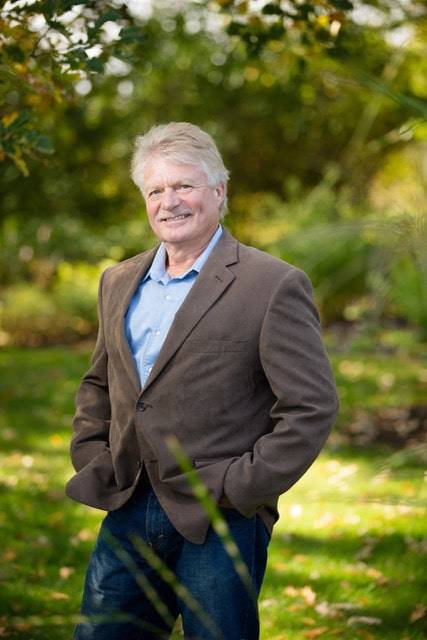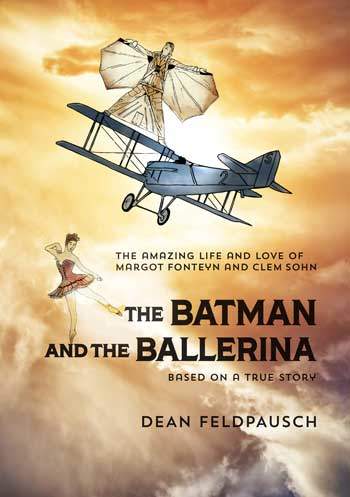By: Anna Faller
It was the perfect love story. A privileged prima ballerina and an agrarian aerial stuntman, entrenched in a clandestine affair, untraceable save for a single exchange. Did it ever happen? Dean Feldpausch thinks it did; “and if [it] didn’t,” he says, “[it] should have.” In his debut historical fiction novel, The Batman and the Ballerina: The Amazing Life and Love of Margot Fonteyn and Clem Sohn, released in mid-September, Feldpausch chronicles the imagined romance of Margot Fonteyn, the world’s greatest ballerina, and Clem Sohn, the first bat-winged flyer. One week prior to what would be the final jump of his career, Sohn sent the performing Fonteyn flowers with a note attached. Just days later, Sohn plunged to his death when his parachute failed to open. Were the two actually connected? The fact of the matter is, we don’t have enough information to know for sure. But, Feldpausch wasn’t about to let the lack of evidence hinder the mighty hand of fate.

Feldpausch’s own discovery of Fonteyn and Sohn was nothing short of serendipity: “When my father-in-law was fighting his battle with cancer, my mother-in-law [would bring] out photo albums. You get a little nostalgic during times like that,” says Feldpausch, “and her photo albums had a bunch of missing pictures. You could see someone had taken pictures out, and I asked her about it – why [were] so many pictures gone? And she replied, ‘Well, that’s because I’ve lent my photo albums to people interested in Clem Sohn, and they took pictures out.’ [At the time,] I knew about Clem Sohn, but I didn’t understand until these albums came out how closely I was related to him through marriage. My mother -in- law was a first cousin of Clem’s, so my wife is a second cousin.” The rest, as it were, is literal history. “[In] going through pictures and family writings,” Feldpausch continues, “I discovered that there [had been] an exchange between Clem Sohn and the world-renowned ballerina Margot Fonteyn. Margot had written in her autobiography about receiving a note and flowers from Clem about week before he passed away in France. So, I wondered, ‘What was the extent of their relationship?’”
Historically, there might not have been a relationship to speak of. Says Feldpausch, “I took up subscriptions with [records services] like Newspapers.com and Ancestry.com to research the personal relations between Clem Sohn and Margot to see if there were connections there. I accessed all kinds of historical data and found virtually nothing about their relationship. But by that time,” he admits, “I had learned so much about the lives that both of them led, that I had fallen in love with them. I [decided] that the world needed to be reacquainted with Clem and Margot. So, when research failed to connect them in a relationship, I decided that I wanted to place them in [one].”

Thus, the inception of The Batman and the Ballerina. It was Clem, however, who truly piqued Feldpausch’s interest. Born in Fowler, Michigan, at the turn of the last century, and even buried in the Fowler Cemetery, Clem Sohn was not only a national celebrity, but a local one, as well. So, his relative anonymity among Clinton County locals came as something of a surprise. “I was talking to people in the area and asking what they knew of Clem Sohn, and I was surprised at how many people in this area didn’t know [of him],” he says. Their parents, however, were another story entirely. In fact, the previous generation of Fowler residents were invaluable to Feldpausch’s research process. “A lot of my research was actually [interacting] face-to-face [with] people who were second party to Clem,” he says. “Most of the people who actually interfaced with him are deceased now, but I was able to obtain stories from the sons and daughters from those who had interfaced with [him]. They were most helpful,” Feldpausch continues, “and they also connected me with other people who knew about Clem. Even today, as I’m doing presentations and doing book signings, I run into people I don’t know who will share a story about Clem.”
But few are more familiar with Clem Sohn’s life and legacy than Feldpausch himself. “I definitely [felt a connection to] Clem,” says Feldpausch. “He was born and raised on a farm, he had a very similar background (except for the aviation) that I have, and honestly, I sometimes felt like I was in his head.” Still, his crusade for candor didn’t stop Feldpausch from taking a little creative license once in a while: “In the end, if you know the story, Clem actually dies while performing his craft, but there is a part of the book that talks about what’s going through his mind when he’s on his last jump. Clem had already decided that he wasn’t going to jump anymore after this French airshow,” Feldpausch explains. “He had told people that; that’s real and true! But before he runs into difficulty with his parachute, as he is descending, he hears the crowd and begins thinking, ‘Maybe I shouldn’t give this up after all!’ And I actually believe that’s what was going through his head.” To fly, as they say, is everything.
But “flying” has many forms, and with his newfound writing endeavor, Feldpausch is doing just that. Though his educational background is actually in information technology, he has always been a writer at heart: “I always have enjoyed writing for personal pleasure. I’ve kept journals over the years, and things like that.” But it was the influence of a high school composition instructor that, even decades later, ultimately inspired him to pursue it professionally. “His name was Dennis Pilmore,” says Feldpausch, “and he gave me confidence to pursue a book like this. His mantra was, ‘Just write.’ Don’t so much care about it being perfect; just write. Enjoy putting your feelings down on paper and just appreciate that process. And I have to admit,” he continues, “when I wrote my book, I didn’t go through paralysis by analysis. In other words, I didn’t try to make my first draft perfect – I just tried to get my thoughts down.”
Still, Feldpausch is no stranger to structure. In fact, he maintains that the “planning the work and working the plan” mentality he honed during his IT years was crucial to the book’s very completion. “I story-booked the entire book out,” he says. “I knew at a high level what was going to be in every chapter before I even started writing the book. Then, I pursued the book in chapter blocks. I would sit down,” Feldpausch continues, “and write a chapter with little concern of grammar and format, and then I’d focus on that chapter. I’d go back and edit, and then send it in for review before starting the next chapter. That worked well for me.”
And not just in the realm of writing, either. Feldpausch firmly believes that his ‘working the plan’ philosophy can be applied to all facets of life. “When you’re looking to do something that’s big, something that takes a lot of time or a lot of effort, break it up into smaller initiatives and then pursue it one initiative at a time. When I first started this book – and probably all authors go through this with their first book – I didn’t know if I was going to finish it. I didn’t know how big a task this was. Anything you want to do in life,” he continues, “if it’s big, the way you can help insure you’ll complete it is to break it into smaller pieces and work at it a piece at a time.” We won’t deny that wings are necessary for flight, but Dean Feldpausch is well on the way to building his. And with only the sky as his ceiling, there just might be a new Batman in town.
